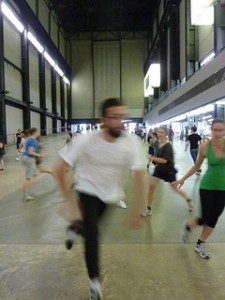Arriving at the Tate Modern, I look down into the Turbine Hall. There is a group of people scuttling around like ants or atoms, avoiding each other, in constant motion. The ‘milling’ seems to be busy, without purpose. Bodies walk quickly in random movements, individuals ‘bunched’ into a group, related to each other by their inexplicable behaviour. I shrug, and go and look at some art.
Later, I exit into the Turbine Hall. Several rows of people jog past, down the length of the hall. I follow them at a more sober pace (although I feel a strange urge to jog after them). I stop as they turn and start to run back towards me. I want to feel the current of air as they pass, to feel the strangeness of being amongst these purposeful bodies. I’m a spectator, but a ‘sensing’ one – the spectacle is an embodied experience.
A figure breaks out of the group and runs with purpose towards me. She is breathing heavily, and sweat shines on her face. She smiles, makes eye contact, and talks breathlessly about the place she calls home. A body, a living, breathing, sweating body confronts me with the intimate details of a lived life – the place she calls ‘home’. I find myself wondering what place I would call home. I’m plunged into intimacy with a complete stranger, and yet she seems not strange any more. Her look is warm, her smile engaging.
Suddenly, her face goes blank. She turns and joins the mass of bodies now walking past; is swallowed up by their glassy stares. I am alienated, reduced to observer.
This experience is repeated several times as the Body of bodies slows to a shuffle. As it advances – slowly – the lights switch off one by one. By the time they reach me, we are in darkness. The feeling is undead, uncanny.
The repeated alienation juxtaposed with intimate personal encounter makes me reflect on the ‘alienation of the other‘ – the amorphous Body that we don’t know personally – whether they be ‘bankers’ or ‘hoodies’. A body that emerges from the ‘Body’, with real lungs and sweat glands to tell me their most personal stories about their homes or mothers, can challenge that alienation. A Body of strangers can move with purpose or seeming randomness – but that one individual can suddenly spin out and confront me reminds me that the ‘Body’ is made up of people who share the humanity of being a physical body in space, with purposes and passions. What makes the ‘Body’ behave the way it does when it is a collection of individuals? It is probably a function of some rules the individuals have agreed, and affected by the responses of the participants that they encounter in the ‘performance.’ Sounds kind of familiar.
‘These Associations’ is an artwork created by Tino Sehgal and can be found in the Turbine Hall of the Tate Modern until 28 October 2012.
